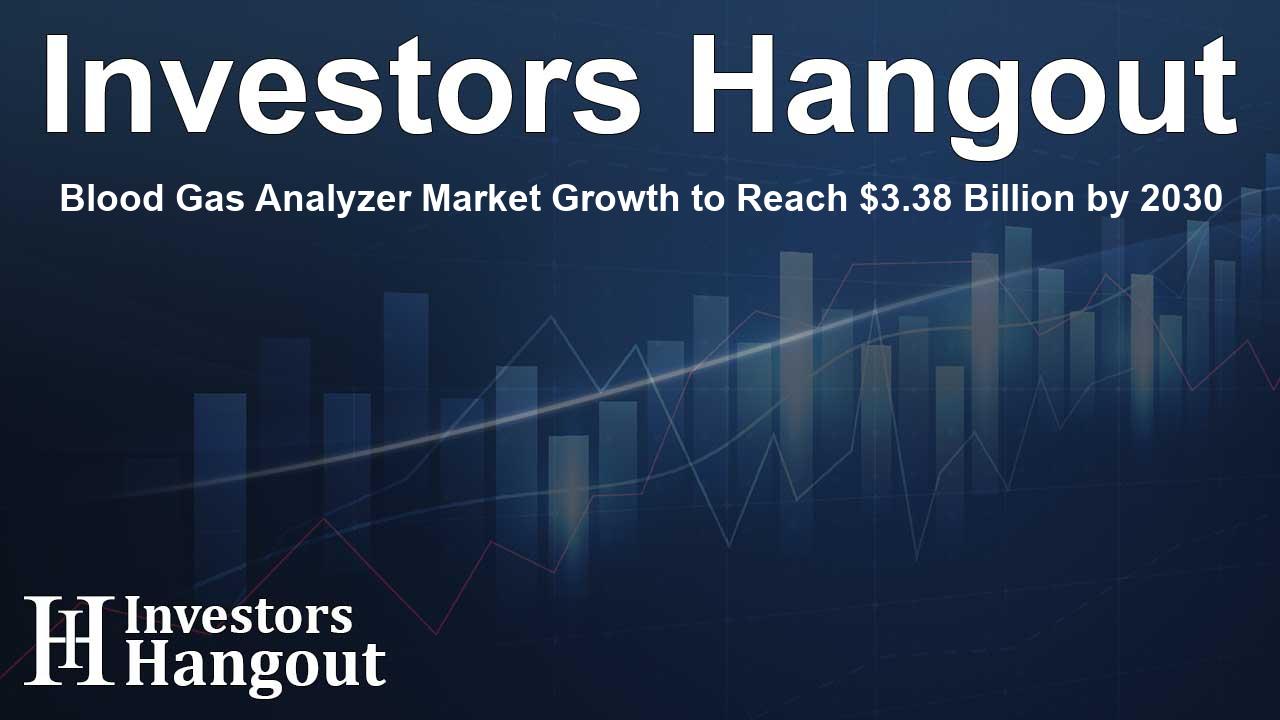Blood Gas Analyzer Market Growth to Reach $3.38 Billion by 2030

Blood Gas Analyzer Market Overview
The blood gas analyzer market is projected to experience substantial growth, with a valuation expected to reach US$3.38 billion by 2030. This reflects a compound annual growth rate (CAGR) of approximately 4.6% as the world increasingly recognizes the importance of rapid and accurate diagnostics in healthcare.
Driving Factors Behind Market Expansion
Several key factors contribute to this growth trajectory. One major driver is the rising prevalence of both chronic and acute diseases, which necessitates frequent monitoring of blood gas levels. The demand for efficient healthcare solutions, particularly in critical settings like emergency departments and intensive care units, is prompting healthcare providers to invest in advanced blood gas analyzers. These devices not only improve patient outcomes but also streamline clinical workflows.
Technological Advancements
Technological innovations play a crucial role in this sector. Modern blood gas analyzers incorporate cutting-edge technology, enhancing the speed and accuracy of tests. Continuous improvements in device efficiency mean that healthcare practitioners can make informed decisions rapidly, resulting in better patient management and care strategies.
Point-of-Care Testing Adoption
Point-of-care testing is another significant aspect driving market expansion. The ability to conduct tests at the site of care reduces wait times and allows for immediate results, which is vital in life-threatening situations. The incorporation of portable blood gas analyzers into emergency and respiratory care settings has further strengthened their critical role in patient management.
Market Segmentation
The blood gas analyzer market is categorized based on sample type and application. By sample type, it includes segments for arterial, venous, and capillary blood, with arterial blood testing expected to hold a prominent market share due to its high accuracy in measuring vital parameters such as oxygen and carbon dioxide levels.
Application Areas
In terms of applications, critical care management leads the way. Intensive care units often require continuous monitoring, driving significant demand for reliable blood gas testing solutions. Other sectors, including emergency care management and respiratory care, are also seeing a rise in analyzer usage due to the critical nature of their operations.
Geographical Insights
Regionally, North America currently dominates the blood gas analyzer market. Robust healthcare infrastructure, substantial investments in advanced diagnostics, and a high incidence of chronic conditions fuel this dominance. The market in Europe and the Asia Pacific is also witnessing growth due to increasing healthcare awareness and improved access to diagnostic facilities.
Competitive Landscape
The competitive landscape includes key players such as Danaher Corporation, Werfen S.A., and F. Hoffmann-La Roche, among others. These companies leverage their advanced research and development capabilities to introduce innovative products that meet the evolving needs of healthcare providers.
Company Highlights
Danaher Corporation stands out as a market leader due to its extensive global distribution network and commitment to addressing diverse testing needs. Its strategic collaborations and technological advancements keep it at the forefront of the industry. Similarly, Werfen's innovative product portfolio ensures that it remains a key player in delivering effective healthcare solutions, enhancing the reliability and speed of diagnostic testing.
Conclusion
The blood gas analyzer market is navigating through an exciting phase of growth, driven by technological advancements and increasing healthcare demands. As we move towards a more health-focused future, investments in these vital diagnostic tools will continue to rise, ensuring better patient outcomes and reinforcing the critical nature of timely and accurate medical assessment.
Frequently Asked Questions
What is the expected growth rate of the blood gas analyzer market?
The blood gas analyzer market is expected to grow at a CAGR of 4.6%, reaching approximately US$3.38 billion by 2030.
What are the key factors driving market growth?
The growth is driven by the rise in chronic diseases, demand for rapid diagnostics, and technological advancements in analyzer capabilities.
What types of blood samples are analyzed?
The blood gas analyzer market segments into arterial, venous, and capillary blood samples, with arterial blood being the most commonly tested.
Which region currently leads the market?
North America holds the largest market share, supported by strong healthcare infrastructure and high investments in diagnostics.
Who are the major competitors in the blood gas analyzer market?
Key players include Danaher Corporation, Werfen S.A., and F. Hoffmann-La Roche, among others, all of which are focused on innovation and market expansion.
About The Author
Contact Caleb Price privately here. Or send an email with ATTN: Caleb Price as the subject to contact@investorshangout.com.
About Investors Hangout
Investors Hangout is a leading online stock forum for financial discussion and learning, offering a wide range of free tools and resources. It draws in traders of all levels, who exchange market knowledge, investigate trading tactics, and keep an eye on industry developments in real time. Featuring financial articles, stock message boards, quotes, charts, company profiles, and live news updates. Through cooperative learning and a wealth of informational resources, it helps users from novices creating their first portfolios to experts honing their techniques. Join Investors Hangout today: https://investorshangout.com/
The content of this article is based on factual, publicly available information and does not represent legal, financial, or investment advice. Investors Hangout does not offer financial advice, and the author is not a licensed financial advisor. Consult a qualified advisor before making any financial or investment decisions based on this article. This article should not be considered advice to purchase, sell, or hold any securities or other investments. If any of the material provided here is inaccurate, please contact us for corrections.
